
Steve Biegacki, FDT Managing Director and Holger Sack, Chairman of PACTware discuss new features available within the updated point-to-point PACTware 6.1 device configuration, parameterization, and management tool that is FDT3 enabled.
Steve
Thank you for joining me for this interview, Holger. Could you describe the details of your position within the PACTware Consortium?
Holger
Sure, I am the Chairman of the Board of the PACTware Consortium. I have been with PACTware since 2010. VEGA has been a member of the PACTware Consortium since the very first beginning as well as other many other companies.
Steve
Could you tell us what PACTware is, and what are its primary application use cases in the industry?
Holger
The PACTware Consortium is a group of companies acting in the process automation as well as in the factory automation world.
Let me say that we have members that are manufacturers of field devices as well as system infrastructure components. But we also have in the group members such as software developing companies that provide some services regarding software development and integration, etc.
Currently, the organization is now 21 companies strong. It must be said that we are acting on a voluntary basis, so we do not have employees and we fund activities and development by ourselves and via member fees.
The intention of the PACTware Consortium is to provide all members and their users a free software tool to perform tasks such as point to point configuration, setup and diagnostic of field devices, a hands-on tool that we like to call our screwdriver tool for all users.
Steve
PACTware is widely adopted and used throughout the industrial automation market space for tasks like device configuration, parameterization, and management. Now we have a new release: PACTware 6.1. What is new with 6.1?
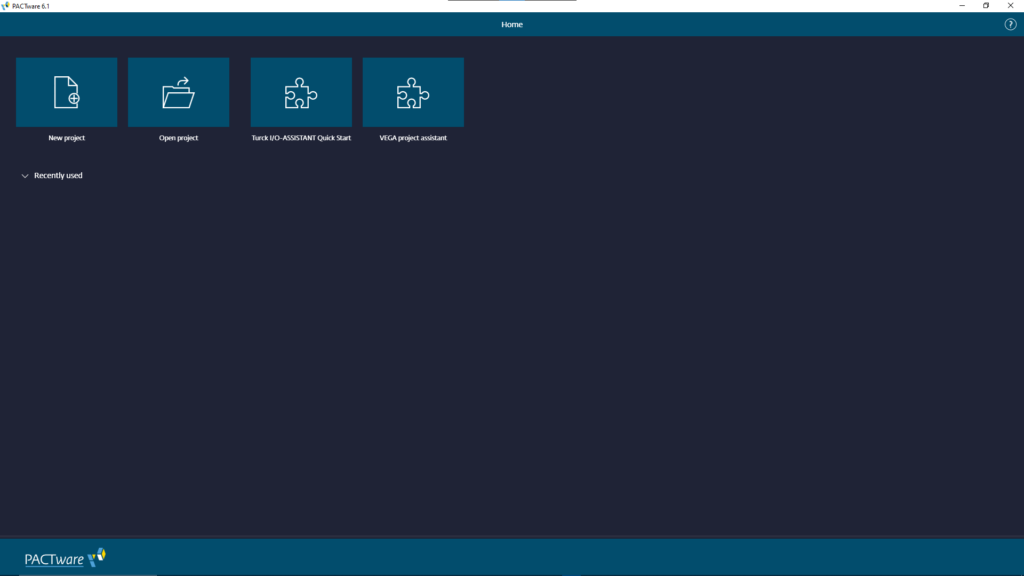
PACTware 6.1 Home Screen
Holger
Well, PACTware 6.1 has new functionalities, but we can mention two major ones.
The first one is of course FDT 3.0 integration. The FDT specification is mature technology and has been a fundamental part of the design concept for our software from the very beginning, that’s nearly 20 years.
And the second significant improvement is the capability to work also with FDI packages. For this purpose, we have implemented a technology called iDTM from the company CodeWrights GmbH, making that technology available for all PACTware users and once again, maintaining the application’s flexibility.
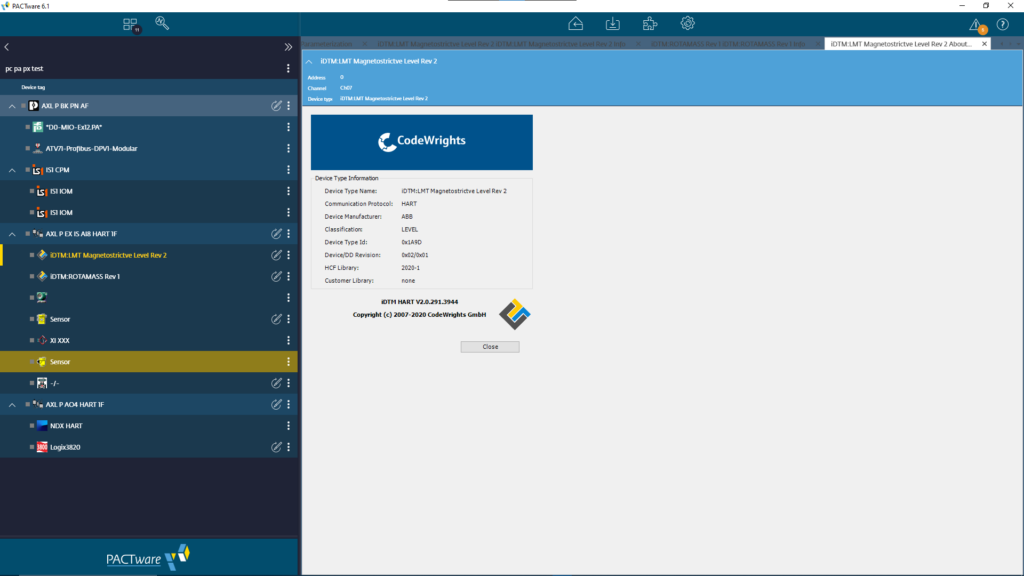
iDTM from CodeWrights integrated into PACTware 6.1 for FDI packages
With these new integration features, PACTware now offers the only free tool supporting all DTM generations and FDI packages.
Since its first beginnings, PACTware was intended to be manufacturer independent, as well as fieldbus type independent, with the goal to provide a universal tool for all our users. Today, the solution is successfully deployed world-wide to simplify point-to-point configuration. With our tool, users have access to use a wide range of devices from companies they are familiar with.
Steve
Yes, I would agree that it is a great universal point-to-point configuration tool, no matter the protocol, device model or data model.
Okay, moving on then. You mentioned that FDI is a new part of the plug and play environment. What is the existing relationship between FDT 3.0 and FDI?
Holger
There is no actual relationship. We just thought in the development of this new version, which features and characteristics would bring additional benefits and make the software more flexible, more universal, etc.
These two features have been integrated, of course, in parallel. The FDT 3.0 standard was created and since this is one of our main key features, we decided to use its universal interface technology for both DTMs and FDI packages.
Of course, FDT has been available for 20 years, so our main technology is FDT technology. Now FDI comes up and that was the reason to say, okay, FDI technology or the integration of FDI packages brings additional benefits for everybody.
Steve
Would it be valid to say that FDT, as an underlying technology within PACTware enables one environment where end users can easily manage all these different device types?
Holger
Yes, correct. This was the huge step we took years ago, when FDT technology was established, that a basic requirement of our tool was to be independent from manufacturers technologies or fieldbus technology and therefore be able to create a universal tool for our users.
Steve
Excellent. Now let’s move on to the subject of backward compatibility, because the great thing about PACTware from the initial version to the new 6.1 version is support for the current install base of DTMs in use today. Can you tell us a little bit about how this works with PACTware 6.1, and will the user see any changes?
Holger
It is one of our main objectives, and a major benefit to our users, to offer a tool that maintains backward compatibility. So, we have worked from the very first day on that functionality, although this task becomes sometimes very difficult and even not possible anymore, due to new technologies that we are using in the background, that are required to keep our tool state-of-the-art.
Therefore, we have a compatibility matrix placed on our website with information about the tool’s compatibility between operating systems, as well as for which versions can work in parallel, and what projects are able to run in the new versions of PACTware.
So, if there is a step needed in the migration from one version to another, it is mainly technology driven, for the compatibility of certain things and we cannot avoid that. Everything that we can implement technology wise, we have done, because we feel that is a major benefit for the users.
Steve
Can you confirm that PACTware 6.1 is backward compatible with all previous generation versions of DTMs?
Holger
Yes, because PACTware supports FDT 1.2, 2.0 and FDT 3.0 all DTMs are supported by PACTware 6.1.
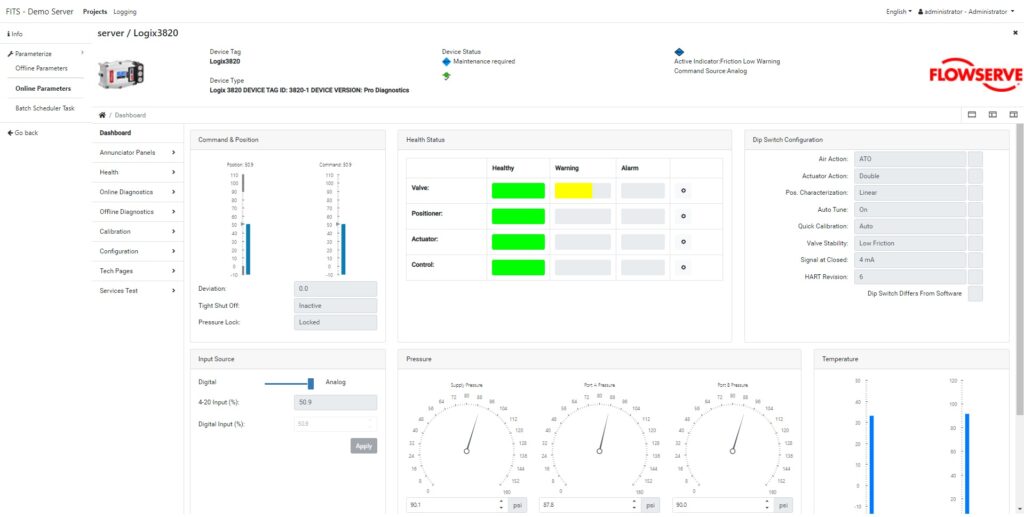
Examples of a FDT 3.0 DTM Prototype from Flowserve
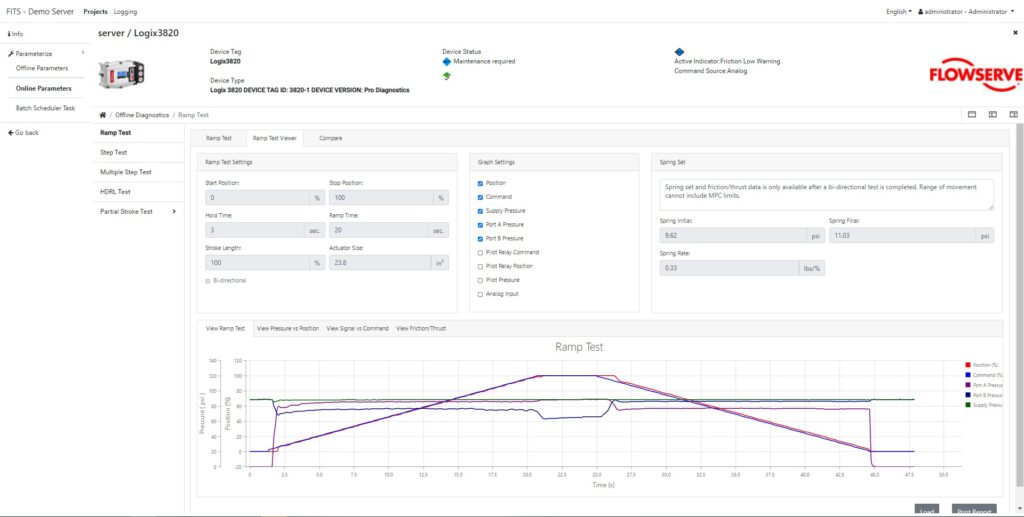
Steve
What are the steps required in the migration to PACTware 6.1 from older versions? Are there specific steps that users need to take during the migration?
Holger
We can say that 6.x can run in parallel with the former 5.0 version to give users the flexibility and security to try the new version first without the uninstallation of the old version.
Therefore, all main versions can run in parallel if the users want to have this safety net in the background.
Additionally, end users must check the hardware requirements needed to run PACTware.
Steve
Does 6.1 run on a particular operating system?
Holger
I can tell you that PACTware 6.1 runs on Windows 10 and 11. This has been tested.
However, it should also run on older operating systems, but we cannot guarantee this because they have not been tested.
This is one point where, if we offer some functionalities, they must be tested. It must be proven by use from all members. Every member takes part during the beta and the release version test phases, otherwise, they must support the Consortium with test fees.
Windows 7 and Windows 8 have reached end of life. Therefore, there is no support for them any longer. So, if users are still using those older OS’s, they are facing a safety risk. So, we recommend every user to migrate to a modern supported OS version.
Steve
Is the migration of current projects to version 6.1 a seamless import process?
Holger
Users of version 5.x can load their projects in version 6.1 without problems. However, users of version 4.x must migrate their projects to version 5.x first, and then they will be able to open them in version 6.1.
We know some of our users, but not the majority, have big projects with a lot of devices connected in the project. But most of our users are working with PACTware, as a point-to-point tool, just for single device setup. For these simple applications, it would be easier to recreate the projects from the beginning with version 6.1 instead of installing 5.x, upgrade them and then use 6.1.
Steve
With 6.1, there is no reason to run parallel operations, correct?
Holger
In most cases, parallel operation is used only in case the users want to test if their projects are running well in the new version. Maybe they want to try all the new functionalities for safety reasons.
If you have installed the newest version, and if you have created your project there, or if you can upload the projects into the new version and you’re happy with all the functionalities, then you continue with one version, the latest. There is no actual need to run two or more than two versions in parallel.
Steve
Do you know what version of PACTware is mostly used today?
Holger
No, sorry. Would be nice to know. We get this question often. But we estimate that we have reached several hundred thousand. We have 20 companies as members for 20 years. For all the Consortium member companies, PACTware is the main tool for setup and analysis of devices.
Steve
Got it! Regarding the interface, will users be able to see and manage everything the way they did with their current or previous version of PACTware?
Holger
This is where we made a major change when we moved from PACTware 5.0 to PACTware 6.0. We created a completely new ‘adjustment concept’ in the background and of course a completely new user interface for our users.
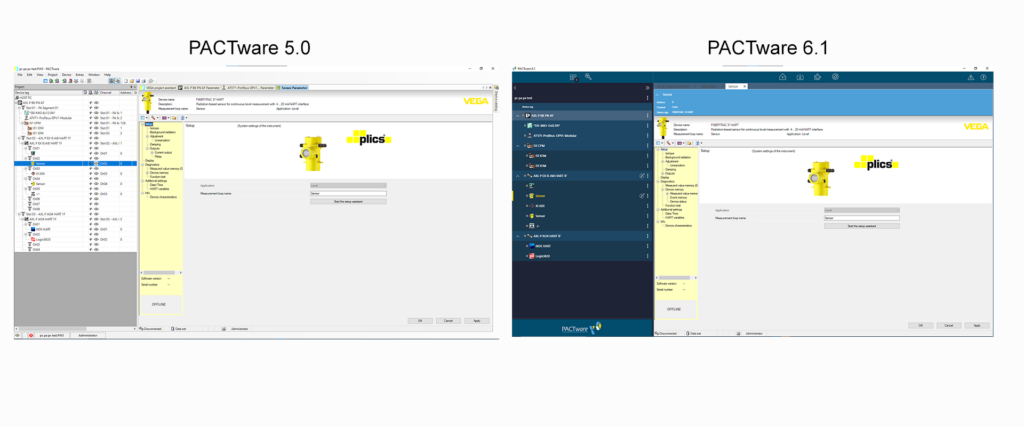
Side by side comparison of the user interface for PACTware 5.0 versus PACTware 6.1
After 20 years of development, the user interface was more complex than necessary, due to the incorporation of new functions that could be accessed in different ways. This was the traditional practice.
Today, the practice has changed a bit, so we decided to simplify the interface for our users, with only one way to reach one function. To help the users define their preferred settings, the intuitive user interface guides them automatically through the process.
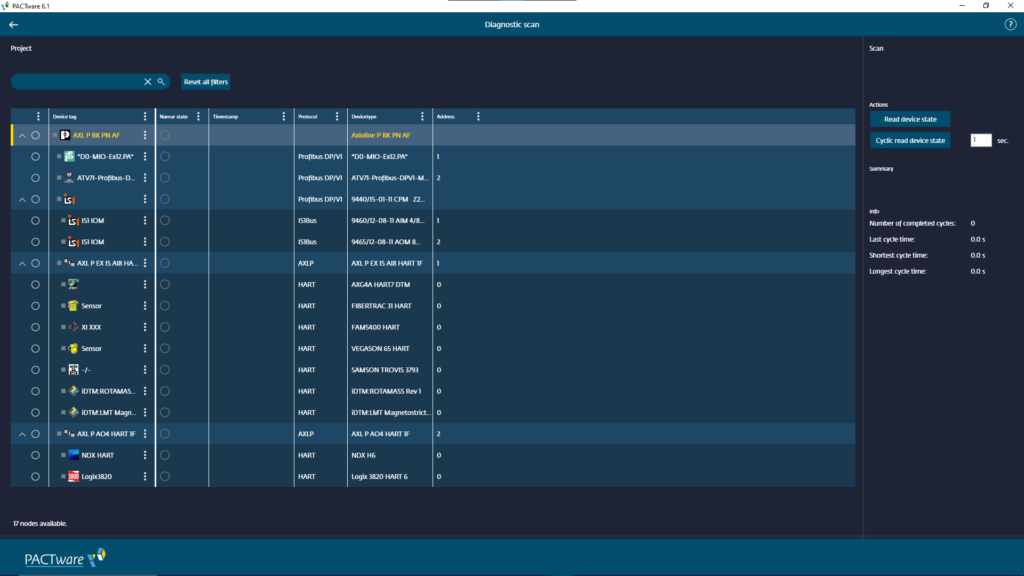
Diagnostic Scan Function
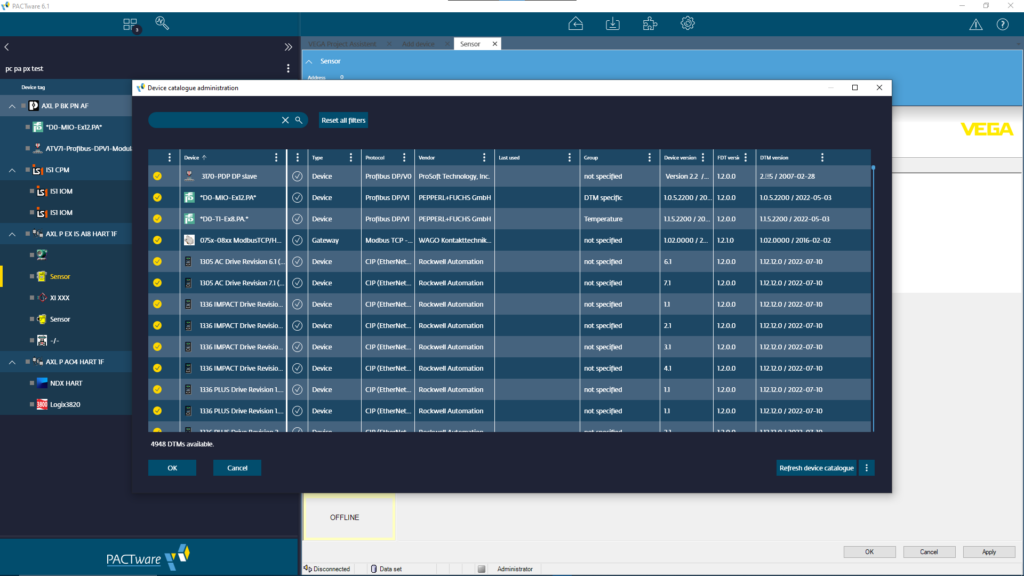
Device catalogue administration function
Additionally, we have improved the interface for touch enabled Windows devices, since there are a lot of mobile devices on the market running that operating system. So, touch adjustments, touch menus, and touch concepts have been implemented in the new interface. This is a huge step for our users. So far, we have not heard about any big problem. It is kind of a challenge.
We are very optimistic with the new design, which took while and was created by user interface specialists, with knowledge on usability and user experience concepts.
Steve
Okay. How does PACTware pave the IIoT pathway for industrial device management and IT/OT operations?
Holger
Well, PACTware has supported device DTMs, communication DTMs, and Ethernet communication DTMs from our member companies and others for a long time.
With our new devices from VEGA, we have integrated wireless Bluetooth technology communications. So, this is our path or step into the direction of IIoT.
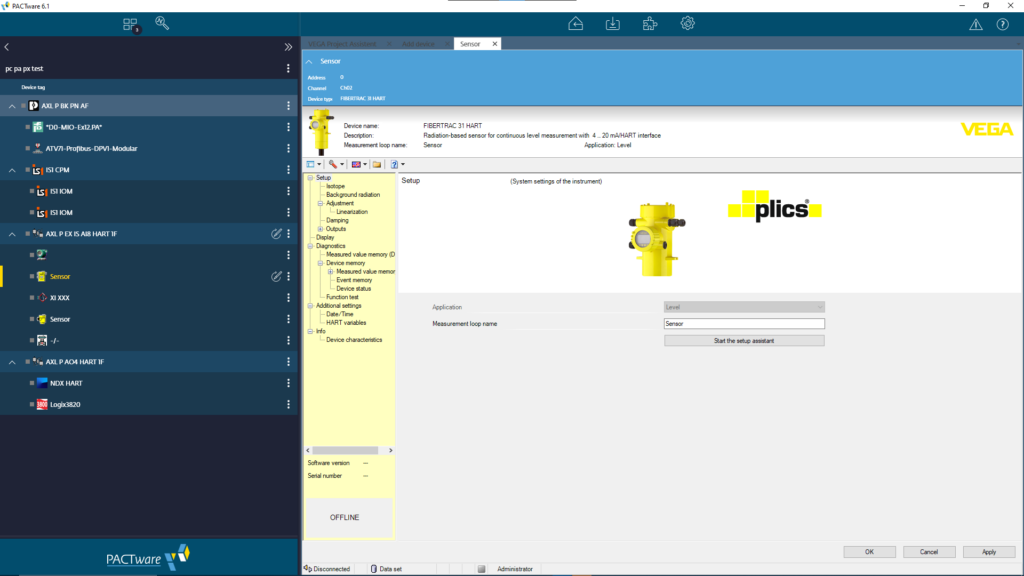
VEGA integration of Bluetooth technology communication to support IIoT initiatives.
I think PACTware is a perfect tool if you talk about the NOA concept from NAMUR, the second channel path through the installation hierarchy or the automation pyramid, to have an independent path to the devices, without interfering with the main communication structure of the system. So, this works very well already.
There is new technology coming that we will implement as soon as it becomes available and stable enough to have specifications.
Steve
Is there a way for users to take advantage of FDT 3.0 DTMs in the PACTware 6.1 environment?
Holger
Yes. This technology is implemented already, so if there is a DTM with a HTML user interface, this will run automatically without any additional setup or configuration.
Steve
Okay, does that mean that, since 3.0 DTMs are HTML enabled, that users will have mobility, or flexibility of access with PACTware?
Holger
No, FDT Server technology is not implemented in PACTware. Our users run PACTware on local machines and host DTMs on the local machine. So, the core is running on local machines, not on server technology.
PACTware requires direct access to the device and therefore the user must first download the DTM or FDI package and integrate it into PACTware. Then, the user can have communication direct to the device or to the structure they are connecting to.
Steve
Okay, are there any add-ins? You talked earlier about software solution providers being part of the PACTware Consortium. Are there add-in functionalities to enable access to the HTML interface with those DTMs in PACTware?
Holger
It’s not planned yet since PACTware is designed as a point-to-point tool.
We do not have plans to implement those features as the next step, but we will continue having those discussion because, as I said at the beginning, we want to be independent for our users, from manufacturers, from technologies.
Steve
What plans are in store for future PACTware releases?
Holger
We are working on adding what we call ‘Download Manager’ to the next version.
This functionality allows the system to automatically recognize the connected devices. Even if the user has not downloaded or installed any DTM or FDI drivers, PACTware itself will guide the user to the website of the supplier of those devices and will offer the operator the option to download the correct drivers or to upgrade them if a newer option is available.
Steve
Is Download Manager a kind of a repository for device drivers?
Holger
No, PACTware will take the users directly to the supplier’s website that holds those device drivers. So, it’s not a repository or hub.
This functionality will only work for devices made by members of the PACTware Consortium at first. You know, there are also license issues to be considered.
But we want to start with that technology first, collect experiences for us and for our users. And maybe afterwards we can extend the technology to include other device driver repository platforms later, including the FDThub.
Steve
In what PACTware version are you thinking of adding Download Manager?
Holger
We are already working on the next version, possibly called PACTware 6.2. And this will be one function for the next version.
Steve
Are there any other features that users of PACTware might be excited about with 6.2 alongside Download Manager?
Holger
At this moment, no, that will be the major new feature.
Meanwhile, everybody is excited about the advancement possibilities available with the new 6.1 version. I would recommend our users not to skip 6.1 because this version has major benefits.
Steve
So, the recommendation is to upgrade to PACTware 6.1 and then once you’re there, then it will be much easier to accept the new features and benefits as they are launched in the future.
Okay, thank you Holger. I think you have provided good insight here.
Holger
You are welcome. It was my pleasure.
PACTware 6.1 is available for download from its’ member community at: https://www.pactware.com/de/service/download